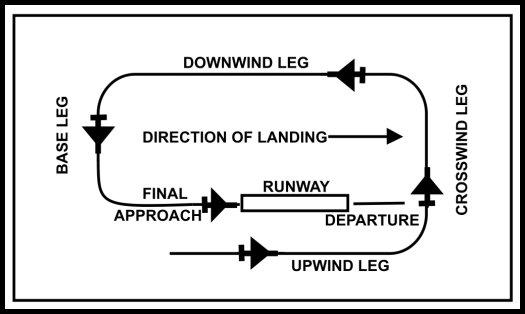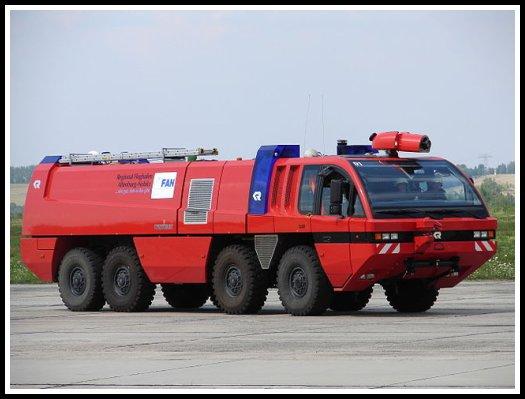Airport operations and management
That's one small step for [a] man; one giant leap for mankind.
- Neil Armstrong, Commander Apollo 11.

Left-hand circuit pattern
Operations
The majority of the
world's airports are non-towered, with no air traffic control presence.
However, at particularly busy airports, or airports with other special
requirements, there is an air traffic control (ATC) system whereby controllers
(usually ground-based) direct aircraft movements via radio or other
communications links. This coordinated oversight facilitates safety and speed
in complex operations where traffic moves in all three dimensions. Air traffic
control responsibilities at airports are usually divided into at least two main
areas: ground and tower, though a single controller may work both stations. The
busiest airports also have clearance delivery, apron control, and other
specialized ATC stations. Ground Control is responsible for directing all
ground traffic in designated "movement areas", except the traffic on
runways. This includes planes, baggage trains, snowplows, grass cutters, fuel
trucks, stair trucks, catering trucks, conveyor belt vehicles and other
vehicles. Ground Control will instruct these vehicles on which taxiways to use,
which runway they will use (in the case of planes), where they will be parked, and
when it is safe to cross runways. When a plane is ready for takeoff it will hold
short of the runway, at which point it will be turned over to Tower Control.
After a plane has landed, it will vacate the runway and be returned to Ground
Control. Tower Control controls aircraft on the runway and in the controlled
airspace immediately surrounding the airport. Tower controllers may use radar
to locate an aircraft's position in three-dimensional space, or they may rely
on pilot position reports and visual observation. They coordinate the
sequencing of aircraft in the traffic pattern and direct aircraft on how to
safely join and leave the circuit. Aircraft which are only passing through the
airspace must also contact Tower Control in order to be sure that they remain
clear of other traffic.
Traffic pattern
All airports use a traffic pattern (often called a traffic circuit outside the U.S.) to assure smooth traffic flow between departing and arriving aircraft. Generally, this pattern is a circuit consisting of five "legs" that form a rectangle (two legs and the runway form one side, with the remaining legs forming three more sides). Each leg is named, and ATC directs pilots on how to join and leave the circuit. Traffic patterns are flown at one specific altitude, usually 800 or 1,000 ft (244 or 305 m) above ground level (AGL). Standard traffic patterns are left-handed, meaning all turns are made to the left. Right-handed patterns do exist, usually because of obstacles such as a mountain, or to reduce noise for local residents. The predetermined circuit helps traffic flow smoothly because all pilots know what to expect, and helps reduce the chance of a mid-air collision. At extremely large airports, a circuit is in place but not usually used. Rather, aircraft (usually only commercial with long routes) request approach clearance while they are still hours away from the airport, often before they even takeoff from their departure point. Large airports have a frequency called Clearance Delivery which is used by departing aircraft specifically for this purpose. This then allows airplanes to take the most direct approach path to the runway and land without worrying about interference from other aircraft. While this system keeps the airspace free and is simpler for pilots, it requires detailed knowledge of how aircraft are planning to use the airport ahead of time and is therefore only possible with large commercial airliners on pre-scheduled flights. The system has recently become so advanced that controllers can predict whether an aircraft will be delayed on landing before it even takes off. That aircraft can then be delayed on the ground, rather than wasting expensive fuel waiting in the air.
Navigational aids
There are a number of aids available to pilots, though not all airports are equipped with them. A Visual Approach Slope Indicator (VASI) helps pilots fly the approach for landing. Some airports are equipped with a VHF Omnidirectional Range (VOR) to help pilots find the direction to the airport. VORs are often accompanied by a Distance Measuring Equipment (DME) to determine the distance to the VOR. VORs are also located off airports, where they serve to provide airways for aircraft to navigate upon. In poor weather, pilots will use an Instrumental Landing System (ILS) to find the runway and fly the correct approach, even if they cannot see the ground. The number of instrument approaches based on the use of the Global Positioning System (GPS) are rapidly increasing and may eventually become primary mean for instrumental landings. Larger airports sometimes offer Precision Approach Radar (PAR), but these systems are more common at military air bases than civilian airports. The aircraft's horizontal and vertical movement is tracked via radar, and the controller tells the pilot his position relative to the approach slope. Once the pilots can see the runway lights, they may continue with a visual landing.
Taxiway sign at Zagreb Airport
Taxiway signs
Airport guidance signs provide direction and information for taxiing aircraft and airport vehicles. Smaller aerodromes may have few or no signs, relying instead on airport diagrams and charts.
Lighting
Many airports have lighting that help guide planes using the runways and taxiways at night or in rain or fog. On runways, green lights indicate the beginning of the runway for landing, while red lights indicate the end of the runway. Runway edge lighting consists of white lights spaced out on both sides of the runway, indicating the edge. Some airports have more complicated lighting on the runways including lights that run down the centerline of the runway and lights that help indicate the approach (an approach lighting system, or ALS). Low-traffic airports may use pilot controlled lighting to save electricity and staffing costs. Along taxiways, blue lights indicate the taxiway's edge, and some airports have embedded green lights that indicate the centerline.
Weather observations
Weather observations at the airport are crucial to safe takeoffs and landings. In the US and Canada, the vast majority of airports, large and small, will either have some form of automated airport weather station, whether an AWOS, ASOS, or AWSS, a human observer or a combination of the two. These weather observations, predominantly in the METAR format, are available over the radio, through Automatic Terminal Information Service (ATIS), via the ATC or the Flight Service Station. Planes take-off and land into the wind in order to achieve maximum performance. Because pilots need instantaneous information during landing, a windsock is also kept in view of the runway.

FLF Panther airport crash tender in Germany
Safety management
Air safety is an important concern in the operation of an airport, and almost every airfield includes equipment and procedures for handling emergency situations. Airport crash tender crews are equipped for dealing with airfield accidents, crew and passenger extractions, and the hazards of highly flammable aviation fuel. The crews are also trained to deal with situations such as bomb threats, hijacking, and terrorist activities. Hazards to aircraft include debris, nesting birds, and reduced friction levels due to environmental conditions such as ice, snow, or rain. Part of runway maintenance is airfield rubber removal which helps maintain friction levels. The fields must be kept clear of debris using cleaning equipment so that loose material does not become a projectile and enter an engine duct. In adverse weather conditions, ice and snow clearing equipment can be used to improve traction on the landing strip. For waiting aircraft, equipment is used to spray special deicing fluids on the wings. Many airports are built near open fields or wetlands. These tend to attract bird populations, which can pose a hazard to aircraft in the form of bird strikes. Airport crews often need to discourage birds from taking up residence. Some airports are located next to parks, golf courses, or other low-density uses of land. Other airports are located near densely-populated urban or suburban areas. An airport can have areas where collisions between airplanes on the ground tend to occur. Records are kept of any incursions where airplanes or vehicles are in an inappropriate location, allowing these "hot spots" to be identified. These locations then undergo special attention by transportation authorities (such as the FAA in the US) and airport administrators. During the 1980s, a phenomenon known as microburst became a growing concern due to aircraft accidents caused by microburst wind shear, such as Delta Air Lines Flight 191. Microburst radar was developed as an aid to safety during landing, giving two to five minutes warning to aircraft in the vicinity of the field of a microburst event. Some airfields now have a special surface known as soft concrete at the end of the runway (stopway or blastpad) that behaves somewhat like styrofoam, bringing the plane to a relatively rapid halt as the material disintegrates. These surfaces are useful when the runway is located next to a body of water or other hazard, and prevent the planes from overrunning the end of the field.
UTC | Zulu Time
Copyright © 2012 Roger. All rights reserved. | Sitemap